
|
| |
DETECTIVE
COMICS, STAR SPANGLED WAR STORIES & SUPERGIRL
INSIDE THE
DC COMICS 1973 D-3 SUPER PAC
|
| |
| |
 |
| |

|
| |
Detective
Comics #433 - Star Spangled War Stories #168 -
Supergirl #4
From
the March cover date publication cycle for 1973
comes DC's Super Pac D-3 which contains two
monthly titles and one that was published eight
times a year (Supergirl).
DC's
comicpacks usually leaned towards grouping titles
which, more or less, had a common denominator. In
the case of this Super Pac, it is however rather
hard to see a thematic link between the three
titles - in effect, they represent entirely
different genres and plot settings: urban
detective tales, war stories, and sci-fi
superhero fantasy. Ultimately, if you bought or
were given the 1973 D-3 Super Pac you simply got
to sample some of the broad variety of DC Comics'
offerings of the early 1970's.
Having
Detective Comics (a title featured
regularly in DC's comic packs of the 1970s) as
one of the visible covers almost always was a
given with Super Pacs: everybody knew Batman, and
he was a powerful selling point DC would not want
miss. However, having the newly launched Supergirl
as the second title facing outwards and thus
visible inside the bag - rather than the well
established Star Spangled War Stories -
seems a bit surprising. If only for that reason,
this did create a somewhat coherent
"superhero" theme, although the Batman
was, at this point in time, more a skilled and
physically trained detective than a superhero
(hence also his exclusively plain clothes
antagonists during much of 1972 and 1973).
Whatever the reasons for this selection and
display preferences - Super Pacs simply weren't
always dictated by an obviously clear logic.
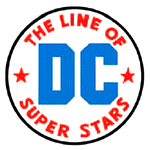
Again, this specific Super
Pac has kept its contents in great shape. With
the plastic bag itself displaying only minor
signs of storage wear (although with some
yellowing) the individual comic books all proved
to be in excellent condition when released more
than 40 years after the plastic bag had
originally been packed and sealed: pristine
covers with perfect gloss and shine on comic
books which were perfectly flat and tight without
any spine stress. The edges were all sharp,
although the cover of Star Spangled War
Stories #168 displayed a crease which,
however, must have almost certainly been
inflicted at the printers as this was the comic
in the middle (and thus often the best protected
one). The pages are all white to off-white, and
the comics looked and felt the way they were as
they came out of the polybag: perfectly clean and
fresh.
It has become a fact of comic
book collecting that a certain online auction
site has become a major (if not the single most
important, due to its global outreach) market
place. The 1973 D-3 Super Pac appears to be on
offer more frequently than others and thus also
shows the often erratic price range in which
comic packs move.
|
|
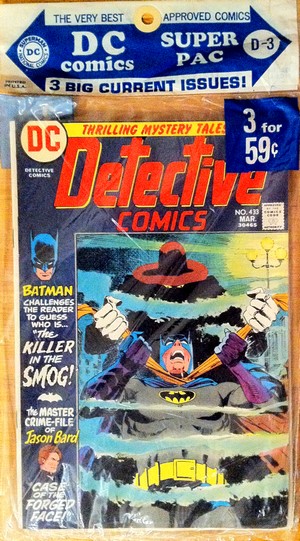 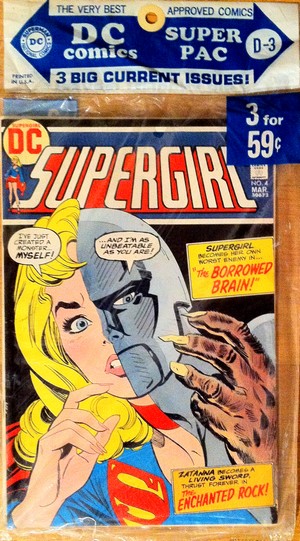
|
|
| |
| In December
2011 it changed hands for $55,99, was again sold in October 2013 but now
for $35,00, was picked
up in January
2014 for $46,00 and then sold again one month later, in
February 2014, except this time for only $20,00, all four
offerings having been described in similar terms of grade
and condition. |
| |
|
| |
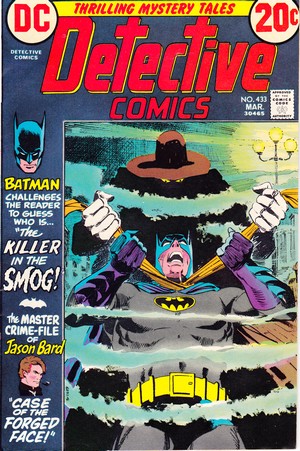
|
|
Detective
Comics #433
March
1973
Editor - Julius
Schwartz
Cover - Dick Giordano
"Killer
in the Smog !" (14,66 pages)
Story - Frank Robbins
Pencils - Dick Dillin
Inks - Dick Giordano
|
|
|
| |
| Whilst Batman tries to
catch up with a mysterious strangler (which he eventually
succeeds in doing) who operates under cover of Gotham's
nightly smog, Jason Bard needs to prevent a planned
assassination of a senator by someone who has
impersonated Bard in three cities. Both stories come from
the pen of writer/artist Frank Robbins and start out by
putting a puzzling situation before the reader which is
eventually unravelled by the main protagonist - Batman
and Jason Bard - who in both cases set a baffled
Commissionar Gordon right. This of course serves as a
clever way of indirectly addressing the reader, making
Gordon to them what Watson is to Sherlock Holmes.
However, Robbins goes a step further in both stories and
actually steps outside of the narrative by directly
asking and thus challenging the reader to match wits with
the two detectives. This is a nice plot device which was
used across the board by DC's writers at the time (see Supergirl
#4, below, for another example) but which greatly adds to
the fun of reading both stories - and also covers up some
minor but nevertheless extant plot elements which are
left dangling after it's all over. The mystery denouements
as such are neither new nor terribly intricate, but they
provide for some highly entertaining 1970s comic book
reading. This is one
of only two issues of Detective Comics for which
Richard "Dick" Dillin (1928 - 1980) drew the Batman; he was far better known for
his 12-year run on Justice League of America.
Frank Robbins (1917 - 1994) on the other hand had a
lengthy run both as writer as well as writer/artist for
Batman in Detective Comics from 1968
to 1973; issue #436 would be his last, and in 1974 he
moved on to Marvel Comics.
An
interesting bonus featured in Detective Comics
#433 is the statement of ownership and circulation, which
was required in print once a year. It shows that whilst
DC printed an average of 332,000
copies of Detective Comics per issue per month during the
preceding twelve month period, only 158,638 of these
(i.e. less than 50%) were, on average, actually sold. It
is a stark illustration of the distribution problems the
comic book industry had in the early 1970s and why the
policy of making unsold copies returnable (and thus
refundable) drove them into a tight corner (which
eventually would lead into the creation of the direct
market).
This relates to DC's Super
Pacs in two ways: First, these figures show just where
exactly the stock used for the sealed 3-packs came from.
And secondly it should be noted that packaged comics were
non returnable. Which of course didn't stop some dealers
from ripping open bags and returning the individual comic
books which hadn't sold as Super Pacs (leading to
specially marked covers as of the mid- to late 1970s to
counteract this fraudulent practice).
The number of subscribers,
by the way, was 616. Which makes it almost seem like a
wonder DC even carried subscriptions.
|
| |
|
| |
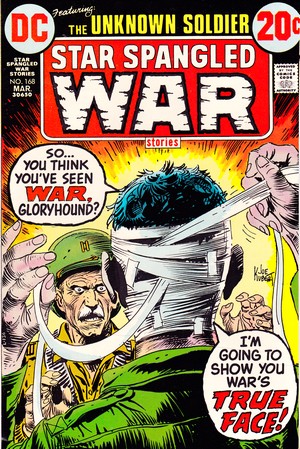
|
|
Star
Spangled War Stories #168
March
1973
Editor -
Archie Goodwin
Cover - Joe Kubert
"The
Glory Hound" (14 pages)
Story -
Archie Goodwin
Pencils & Inks - Jack
Sparling
|
|
|
|
| |
| Created by Robert Kanigher
and Joe Kubert, the Unknown Soldier is an interesting
World War Two story concept that works really well. As
the "man whom no one knows - but is known by
everyone", his head and face are so severely
disfigured that he typically has it completely wrapped in
heavy bandages. Adding to that air of mystery surrounding
his person, he is deployed on various missions as a US
intelligence agent - often under the code name of
"The Unknown Soldier". The success of his
missions relies to some extent on his ability to produce
masterful facial disguises, allowing him to assume the
identity of almost any man using latex masks and make-up.
In Star Spangled War Comics #168,
however, we see none of that; the Unknown Soldier has
barely made it back from behind enemy lines and needs to
convince a glory hounding lieutnant to fall back with his
platoon or else be obliterated by an impending large
scale German counter-attack. The second feature is based
on an historical event - the last Zeppelin raid on
Britain in August 1918 and the shooting down over the
North Sea of Zeppelin L70 with the chief commander of
Germany's Zeppelin fleet on board. Like a few other comics packaged into
the middle of these bags - without their covers actually
visible and therefore in all probability judged to be the
least sellable at the time - Star Spangled War Comics
#168 is actually a true gem. From a personal point
of view, it is the best comic book in this Super Pac by a
substantial margin, with tight storytelling in both
features and artwork to match it ("The Last
Raid" even being a solo production effort by Tom
Sutton (1937 - 2002), prolific artist for both DC and
Marvel and maybe best known for his horror and sci-fi
artwork). I'm also absolutely sure I would have enjoyed
this just as much as a kid or teenager.
As with Detective
Comics #433, this issue of Star Spangled War Comics prints
the
statement of ownership and circulation (or, as editor
Archie Goodwin calls it on the letters page, apologizing
for the fact that it eats up half of that space,
"the who-owns-what statement"): of an average
of 288,000 copies per
issue per month during the preceding twelve month period,
only 145,761 of these (i.e. just over 50%) were, on
average, actually sold. It is a slightly better track
record than what Detective Comics had to show, but still bad enough,
and it shows that it was a situation which concerned not
just one or two titles, not even just one publisher, but
the industry at large.
The number of subscribers,
by the way, was 216. Which makes it almost seem silly
that DC even carried subscriptions - but then again the
figure was up from 108 twelve months previously. From
today's perspective, the "who-owns-what
statement" is most certainly both entertaining and
insightful.
|
| |
|
| |
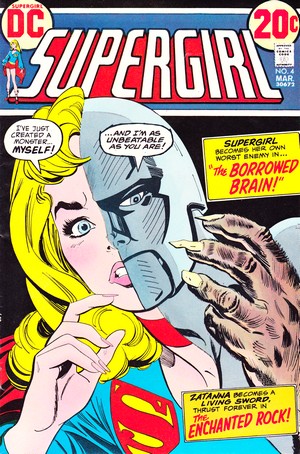
|
|
Supergirl
#4
March
1973
Editor
-Robert Kanigher
Cover - Bob Oksner
"The
Borrowed Brain !" (17
pages)
Story - Cary
Bates
Pencils - Art Saaf / Inks - Vince
Colletta
"The
Rock of Revenge" (6
pages)
Story - Cary
Bates
Pencils & Inks - Don Heck
The
adventures of the original
Supergirl - Superman's cousin
Kara Zor-El whose cover identity
is university student Linda
Danvers - had been a long
standing feature of Adventure
Comics before she got her own
title in 1972, of which this is
issue #4.
|
|
|
|
| |
| Linda Danvers is falling
for one David Grahm, but unbeknownst to her his
enrollment at Vandyre University is only a cover for his
life as the boss of a crime gang. When Supergirl has to
stop an earthquake nearby, Grahm saves one of Linda's
roommates from hitting a loosened chunk of concrete at
the bottom of the University swimming pool. Whilst this
is all for the sake of improving his nice guy cover, he
himself sustains severe brain injury and falls into a
coma. Driven by feelings of love and self reproach,
Supergirl uses Kandorian (the miniature Krypton city
under glass in Superman's Fortress of Solitude) surgery
equipment to transfer some of her brain cells to David.
He recovers, but because Supergirl's cells multiply he
finds he has gained super-powers. Creating a costume with
a lead mask, he becomes Super-Scavenger, and when
Supergirl tries to apprehend him after a robbery, he
fights her off with what is in effect her own
super-strength. This however proves to be only temporary,
so Supergirl gets the upper hand after all. If today's comic books can often be
tedious for being far too drawn out (decompressed
being the euphemism used for that narrative style), this
is a case of the opposite: a done-in-one packing way too
much into a mere 17 pages. The result is a storyline that
goes off in all kinds of directions fast but never seems
to take its time to actually work things out, and before
you know it - it's all over. Needless to say that
although Cary Bates (who was 25 when he wrote this story)
did his best to explain a lot of things and avoid
loopholes in plot logic it all remains very superficial.
And readers like myself (who have next to no knowledge of
the Superman Universe) were probably left a bit confused
by the Super-Scavenger's sudden loss of powers, as Bates
fails to recall (or, in my case, explain) that all
Kryptonian power-transfer cases are only temporary.
All in all, this feels more
like a 1960s comic book, in spite of DC's almost
desperate attempts to be hip: Supergirl is not only the Girl
of Steel but also the Maid of Might -
although that seems nothing compared to Zatanna (the
back-up feature) who is coined the Saucy Sorceress...
In both stories Bates
interrupts the story for a moment asking the readers to
make a guess as to how things will continue:
READER
- DO YOU DARE GUESS WHAT
HAS MADE DAVID EVEN MORE
CUNNING THAN BEFORE ?
READER
-- MATCH WITS WITH ZATANNA
AND SEE IF YOU CAN FIGURE OUT WHAT SHE'S
PLANNING !
It's a nice touch, but the
Zatanna story is even more far-fetched and cheesy than
the Supergirl tale, and it outright collapses onto
itself. It will be evident from these remarks that the
plotting of Supergirl #4 is utterly
unimpressive, and both the artwork by Art Saaf (1921 -
2007) and Don Heck (1929 - 1995) is just as bland. Now
tastes vary of course (the letters page has nothing but
praise from the readers, half of which are female), but
this is another example of a comic book whose cover was
visible in a DC Super Pac yet at least today proves to be
by far the least interesting of the trio.
But then it would seem that
this is not just today's take on the first volume of Supergirl
- the title only lasted for 10 issues, after which the
heroine appeared regularly in Superman Family.
|
| |
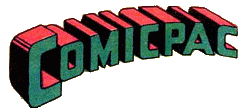
Read more
about comic packs here
|
| |
|
| |

|
| |
Page
first posted 19 December 2013
Revised and repostted 17 April 2014
Text
is (c) 2013-2014 A. Wymann
The illustrations presented here are copyright material.
Their reproduction in this non-commercial context is
considered to be fair use.
|